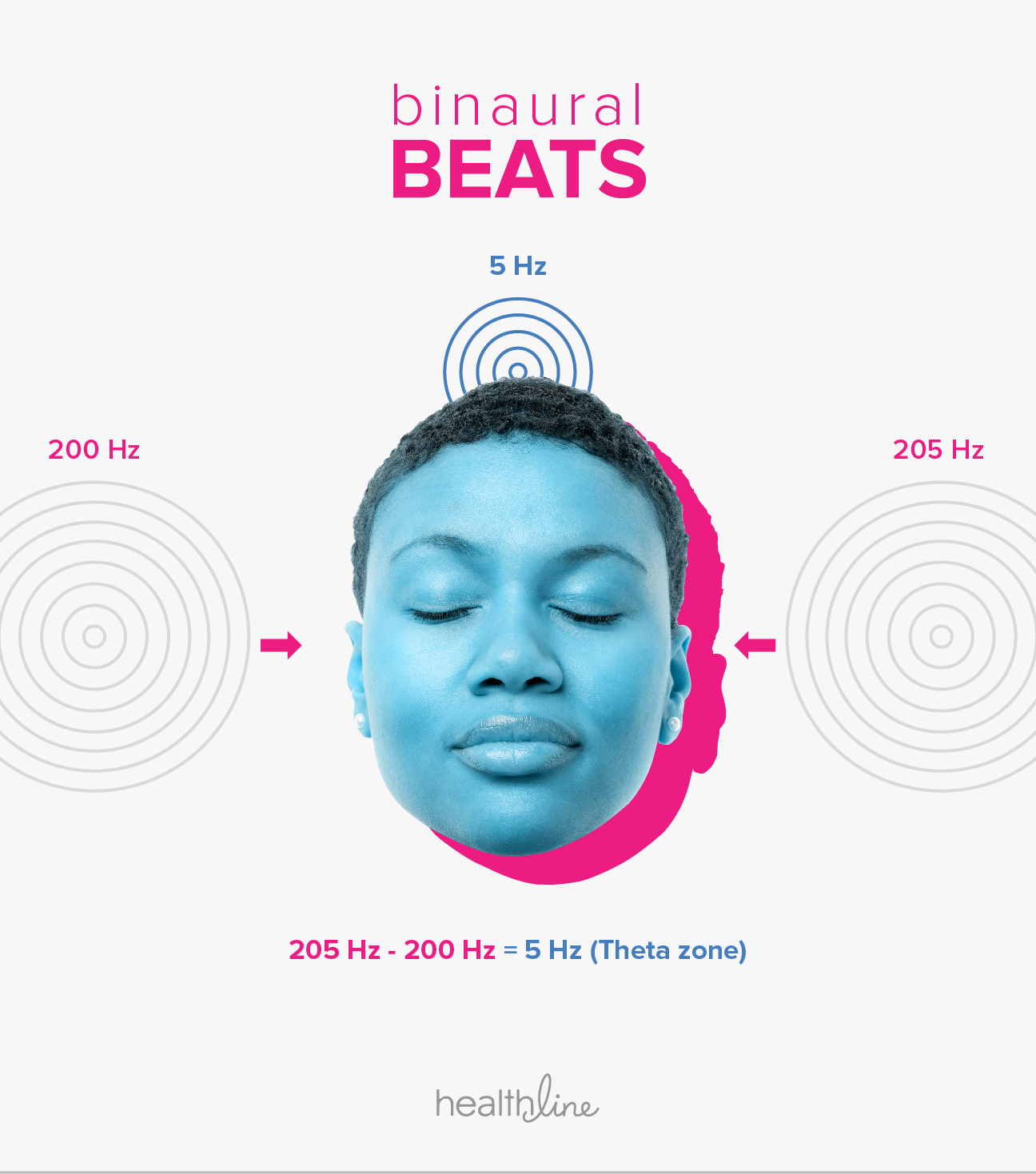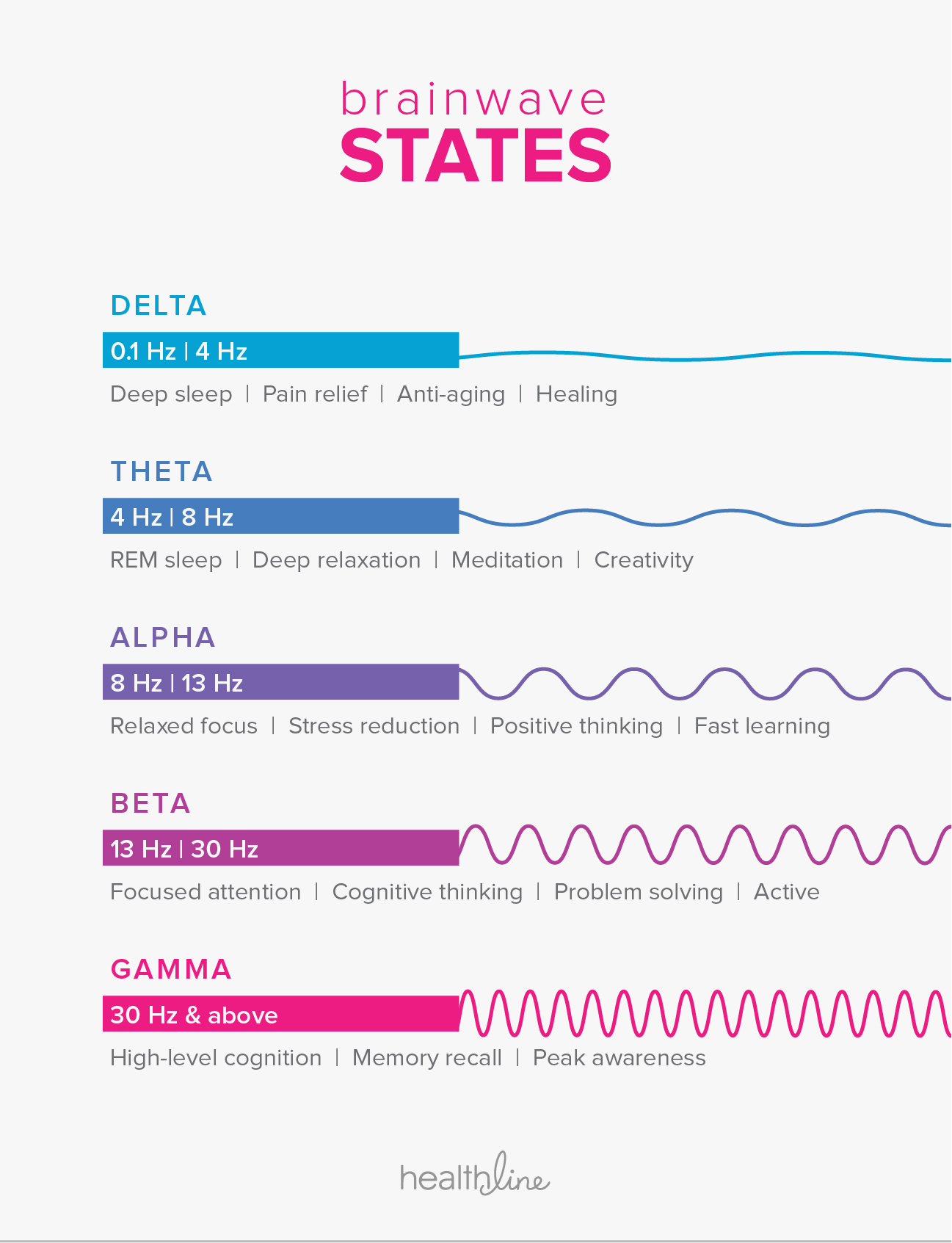6/17/18
This Is Your Brain on Binaural Beats
How these otherworldly sounds may help you hear your way to a happier, healthier you.

For as long as she can remember, Jessica Trimberger has lived with anxiety. “I find it hard to be motivated and am generally jittery,” she says.
Trimberger, who owns a company that makes small-batch beauty products, also has trigeminal neuralgia — a facial nerve disorder often called the “suicide disease” due to its painful and hard to control flare-ups.
“Anxiety and stress are some of my largest triggers,” she says, adding that the medications she’s tried have only left her groggy and feeling “out of it.”
But nine months ago, Trimberger found something that did help her feel better: a soundwave phenomenon known as binaural beats — subtle, surreal beats that are sometimes cocooned in relaxing music and seem to pulsate deep inside the brain.
When Trimberger first learned about binaural beats, she says she began searching and found a free recording online. Thinking “it couldn’t hurt,” she listened and found the experience was better than she expected.
After just 10 minutes, she became relaxed enough to better tolerate her pain.
Encouraged, she listened again, night after night. A month of binaural beats later, Trimberger says she noticed something miraculous. “I was happier, better rested, and not in pain,” she says. “[Binaural beats] are one of the best things to happen to me.”
The illusion of binaural beats
If you’ve ever done an online search for “stress relief” or “anxiety cure,” chances are you’ve already heard of binaural beats. These otherworldly beats are big on YouTube, promising to cure everything from insomnia to fear, while improving poor memory and an anemic happiness level.
While it may be easy to dismiss binaural beats as the next wellness gimmick currently enjoying its 15 minutes of fame, there’s some science behind these sounds… which aren’t actually sounds at all.
Experts credit a Prussian meteorologist named Heinrich Wilhelm Dove for discovering binaural beats way back in 1839. Also called “brain entrainment,” they’ve largely been considered an oddity more than a useful medical treatment.
“Binaural” means “relating to both ears.”
When you play a tone with a slightly different frequency into your left and right ear — say, 200 hertz (Hz) in one and 210 Hz in the other — they travel separately to your inferior colliculus, the part of your brain that gathers auditory input. There, the tones “squelch” together into a so-called “beat” at a perceived new frequency. (In this case, it would be 10 Hz.)
Although it sounds hard to believe, essentially, “you’re hearing something that’s not really there,” explains Troy A. Smith, PhD, an assistant professor of psychological science at the University of North Georgia in Gainesville, Georgia, who has studied binaural beats.
No one is arguing whether or not they exist, by the way. “The question is,” says Smith, “do they influence cognitive processes?”
In other words, what the heck do they do to your brain?

Some people believe that once binaural beats introduce a new frequency to your brain, your brain waves feel compelled to sync to it, effectively launching you into a different “brain state.”
Your brain has five different types of waves. Generally speaking, low-frequency waves are linked to “delta” and “theta” states which can boost relaxation and improve sleep. Higher frequencies reportedly boost your brain waves into a “gamma” state which may make you more alert, focused, or better able to recall memories.
Mid-range frequencies have been linked to attention. Your brain moves into an “alpha” state when your focus turns inward (as in meditation) and a “beta” state when your attention is tuned to the world around you.

“There’s lots of evidence that brain waves correlate with these stages,” says Smith, and makers of binaural beats believe they can help people navigate between them all.
Since opening their online store in 2011, Binaural Beats Meditation has served “hundreds of thousands” of customers, according to James Matthews, the site’s customer happiness manager. “We continue to see an increase in interest… from individuals, but increasingly so from therapists using the music to help clients, health and wellness organizations, and businesses around the world.”
What are the most common reasons their customers are motivated to try binaural beats? “Anxiety, stress, and sleep,” Matthews says. “We also have many people using our music for pain relief, either as an alternative or complementary addition to prescription medication — depending on the severity of their condition.”
The concept of binaural beats isn’t that different from music.
“Humans have enjoyed and benefited from music for thousands of years,” says Matthews. “The work we’re doing seeks to continue this tradition and help people find increased happiness and well-being through the power of sound.”
Some studies — albeit small ones — show that binaural beats can have a positive effect.
For instance, a Montreal study of 15 “mildly anxious” volunteers found a significant reduction in their anxiety when they listened to binaural beats at least 5 times each week for a month.
During a European study, 15 young elite soccer players were asked to listen to binaural beats during their sleep for 8 weeks. They swear they slept better.
And when researchers in Richmond, Virginia, requested 36 adults with chronic pain to listen to two recordings of binaural beats for 20 minutes each day for 2 weeks, 77 percent felt their pain lessened.
There’s even some evidence that binaural beats can have more than mental health effects. Some data indicates they may even be effective at managing tinnitus (ringing in your ears).
Still, not everyone is convinced they’re a panacea.
“I have taken a lot of physics classes and still would not say this is real or makes sense,” says Dr. Clifford Segil, a neurologist at Providence Saint John’s Health Center in Santa Monica, California.
The beat goes on?
Segil says binaural beats are being marketed as a “modern biofeedback mechanism.” And while he feels no harm can come from listening to them — so long as people don’t crank the volume for long periods of time and damage their hearing — he’s quick to point out: “The benefits are less clear.”
“Binaural beats may be good for meditation and relaxing, but that is probably all they are good for,” Segil says. “It’s challenging to say listening to these tones is going to cause a person’s brain waves, as measured on an EEG (electroencephalogram), to synchronize with the tone’s frequencies.”
The brain pathways for sound tracks through the brain stem, then into the thalamus, and then into the auditory cortex. Segil says he’s unaware of any legitimate research that notes binaural beats stimulate this pathway any more than white noise or calming music. (Both of which havebeen extensively studied.)
“Listening to calming music in our busy lives probably does reduce stress and reduce anxiety, but it’s challenging to say that these tones can increase focus, concentration, or confidence,” he adds. “I would think that listening to ‘elevator music,’ classical music, and music like Enya are equally likely to result in these benefits.”
Last year, Smith and one of his students, Lynn Cameron, studied the effects of binaural beats on long-term memory. The first experiment didn’t show that listening to binaural beats had any measurable effect. Neither did the second. Or the third.
But during that final experiment, which monitored participants with EEGs, they did notice something interesting.
When participants listened to binaural beats, their neuroactivity changed. “Binaural beats did seem to change the way participants’ brains processed information during the study, but it didn’t necessarily make it better,” Smith says.
In other words, binaural beats do something to the brain, but exactly what isn’t yet clear.
If someone tries binaural beats and feels it meets their expectations — whatever they may be, “it may be that they’re cued into the part of the change that worked for them,” says Smith, “but we have no idea what works for some people and not others.”
Should you march to this new beat?
“If you’re not paying for it, it can’t hurt,” says Smith.
Segil agrees. “I think taking time to relax during our busy lives and carve out time to meditate and listen to music is beneficial,” he says. “[Binaural beats] are probably reasonable to use while meditating or doing yoga, but I would not expect them to make you ace a test.”
Nevertheless, for people like Jessica Trimberger who say listening to these sounds are having a positive effect on their well-being, it’s an outcome that’s, well… hard to beat.
Trimberger says she now faithfully listens to binaural beats for roughly 20 minutes each day. Since adding them to her daily routine, she claims she’s been able to stop taking medication for her trigeminal neuralgia. She says the flare-ups she used to endure roughly once a month have also disappeared.
“Binaural beats have changed my life in a way I cannot even explain,” she says. “I sleep better every night. I am in less pain. I feel less stress and anxiety. It’s made almost all aspects of my life better.”
Listen to a selection of various binaural beats in the videos below:
Other News
4/07/16
5 Early Signs Your Parent Or Grandparent May Have Dementia
Kimberly Williams-Paisley is opening up about her mother's struggle with dementia. Experts say there are important signals to watch out for if you're concerned about a loved one. Kimberly Williams-Paisley is coming forward about her…
3/17/16
2 Easy Things You Can Do to Prevent ‘Salon Stroke’
Leaning back and getting your hair washed at the salon is uber-relaxing. Except, of course, when it's causing a STROKE. A few days ago, we here at The Stir told you about a 48-year-old California…